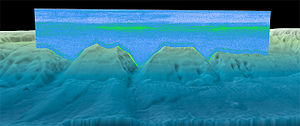

The deep scattering layer, sometimes referred to as the sound scattering layer, is a layer in the ocean consisting of a variety of marine animals. It was discovered through the use of sonar, as ships found a layer that scattered the sound and was thus sometimes mistaken for the seabed. For this reason it is sometimes called the false bottom or phantom bottom. It can be seen to rise and fall each day in keeping with diel vertical migration.
Sonar operators, using the newly developed sonar technology during World War II, were puzzled by what appeared to be a false sea floor 300–500 metres (980–1,640 ft) deep at day, and less deep at night. Initially, this mysterious phenomenon was called the ECR layer using the initials of its three discoverers.[2] It turned out to be due to millions of marine organisms, most particularly small mesopelagic fish, with swim bladders that reflected the sonar. These organisms migrate up into shallower water at dusk to feed on plankton. The layer is deeper when the moon is out, and can become shallower when clouds pass over the moon.[3] Lanternfish account for much of the biomass responsible for the deep scattering layer of the world's oceans. Sonar reflects off the millions of lanternfish swim bladders, giving the appearance of a false bottom.[4]
- ^ Cite error: The named reference
NOAAwas invoked but never defined (see the help page). - ^ Carson, Rachel (2011) [1951]. The Sea Around Us. Open Road Media. ISBN 978-1-4532-1476-3.
The discovery was made by three scientists, C. F. Eyring, R. J. Christensen, and R. W. Raitt, aboard the USS Jasper in 1942...
- ^ Ryan P "Deep-sea creatures: The mesopelagic zone" Te Ara - the Encyclopedia of New Zealand. Updated 21 September 2007.
- ^ Cite error: The named reference
Cornejowas invoked but never defined (see the help page).